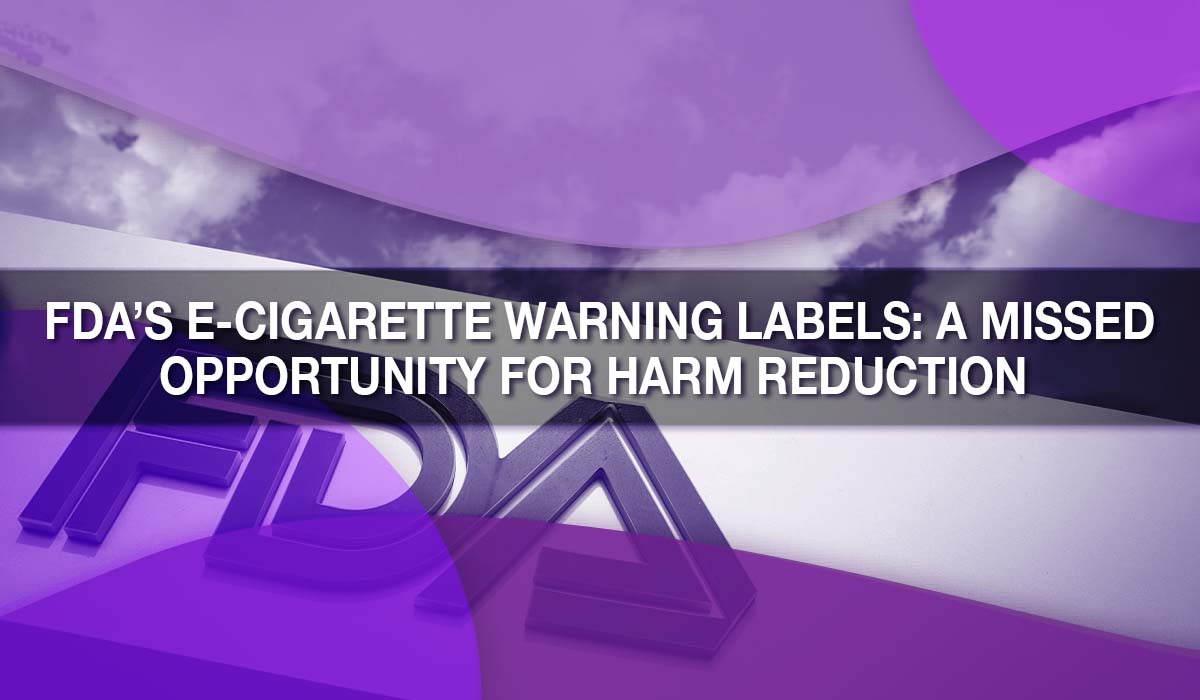
FDA’s E-Cigarette Warning Labels: A Missed Opportunity for Harm Reduction
A recent study published in Tobacco Control tested a series of potential new warning labels for electronic cigarettes (e-cigarettes), highlighting various health risks beyond the FDA’s current nicotine addiction warning. These warnings, which focus on themes such as metals exposure, DNA mutation, cardiovascular problems, and lung damage, aim to increase awareness about the potential risks of vaping. However, they also raise a critical question: Is the FDA missing the mark by focusing on fear-based warnings instead of promoting harm reduction for adult smokers?
The Study: Expanding Warnings, Expanding Confusion?
The study involved 1,629 adult participants, including vapers, smokers, and dual users. It tested additional warnings about:
- Metals Exposure: Risks of inhaling trace metals like lead or nickel.
- DNA Mutation: Potential long-term risks tied to chemical exposure.
- Cardiovascular Problems: Associations between vaping and heart issues.
- Chemical Exposure: Presence of harmful substances in e-cigarette aerosols.
- Lung Damage: Respiratory risks, including irritation or injury.
- Impaired Immunity: Potential impacts on the immune system.
While the warnings heightened risk perceptions, they often failed to provide necessary context, such as how these risks compare to the well-documented dangers of smoking combustible cigarettes. Worse yet, they risk undermining public health by discouraging smokers from switching to alternatives like e-cigarettes.
Where the FDA Gets It Wrong
The FDA’s focus on adding alarming warnings to e-cigarette products reflects a broader failure to embrace harm reduction as a core strategy for addressing tobacco-related deaths. The United Kingdom has embraced vaping and promotes research that shows it is significantly less harmful than smoking. A Vaping to Quit Smoking website is hosted by the National Health Service.
The FDA’s approach seems intent on equating combustible cigarettes and e-cigarettes in the minds of consumers. This is a dangerous precedent that could have dire consequences for public health.
-
Ignoring Relative Risk
By emphasizing risks like “metals exposure” or “DNA mutation” without context, these warnings leave the impression that e-cigarettes are as harmful—or even more harmful—than traditional cigarettes. This misinformation risks deterring smokers from switching to vaping, a tool that numerous studies have shown to be at least 95% less harmful than smoking. -
Pushing Smokers Back to Cigarettes
The study found that smokers and dual users exposed to these warnings were more likely to stick with combustible cigarettes, believing the risks of vaping to be comparable. This is a tragic failure in messaging, as smoking remains the leading cause of preventable death in the U.S., responsible for nearly half a million deaths annually. -
Overlooking the Role of Harm Reduction
While the FDA remains focused on stringent regulations and graphic warnings for e-cigarettes, it fails to address the reality that harm reduction—encouraging smokers to transition to less harmful alternatives—is a proven strategy to reduce smoking-related deaths. Instead of helping smokers quit, the FDA’s approach seems more intent on discouraging all forms of nicotine use, even if it comes at the expense of public health.
The Case for Harm Reduction
E-cigarettes are not without risks, but studies have shown they are far safer than smoking combustible tobacco. Research from countries like the UK and New Zealand, where public health authorities actively promote vaping as a safer alternative, shows dramatic declines in smoking rates and associated diseases. Yet, in the U.S., the FDA has adopted a prohibitionist stance that treats all nicotine products as equally harmful—a stance that ignores decades of evidence and could cost lives.

The new warnings tested in this study reflect a broader anti-harm-reduction ideology that prioritizes fear over facts. By failing to educate smokers about the relative risks of vaping versus smoking, the FDA perpetuates myths and stigmas that undermine its own public health goals.
What Should the FDA Do?
If the FDA genuinely wants to reduce the toll of tobacco-related diseases, it must rethink its approach to e-cigarette regulation and public education. Here’s how:
- Emphasize Relative Risk: Warning labels should make clear that, while e-cigarettes are not risk-free, they are far less harmful than smoking. For example: “Switching completely to e-cigarettes significantly reduces your exposure to harmful chemicals compared to smoking.”
- Support Harm Reduction: The FDA should actively promote vaping as a safer alternative for adult smokers who struggle to quit using traditional methods. This includes approving a wider range of vaping products for adult use and ensuring they remain accessible.
- Focus on Science, Not Fear: Public health messaging should be grounded in evidence, not alarmist rhetoric. Warning labels that exaggerate risks without context only sow confusion and mistrust.
- Invest in Youth Prevention, Not Prohibition: Protecting youth from nicotine addiction is essential, but it can be achieved through targeted measures like strict enforcement against underage sales, rather than broad bans or fear-based campaigns that harm adult smokers.
A Missed Opportunity
The FDA’s continued focus on vilifying e-cigarettes without promoting harm reduction is a missed opportunity to save lives. Smoking kills, and vaping offers a safer alternative for millions of Americans seeking to quit. Public health policies that fail to communicate this reality do more harm than good, perpetuating the very crisis they aim to solve.
It’s time for the FDA to move beyond prohibitionist tactics and embrace harm reduction as the cornerstone of its tobacco control strategy. The stakes are too high for anything less.









Leave a comment
This site is protected by hCaptcha and the hCaptcha Privacy Policy and Terms of Service apply.